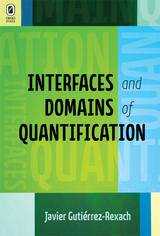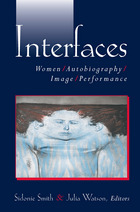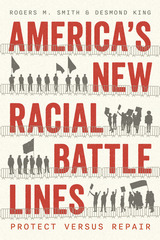
Interfaces and Domains of Quantification advocates an interface approach to the grammar of Spanish quantification. Only a precise characterization of the syntactic properties of quantificational constructions and of their associated meanings allows us to understand how more general syntactic and semantic constraints are at work. Among other findings, the interaction of scope and parallelism with ellipsis is reconsidered; the structural significance of modal anchoring and essential properties for the interpretation of indefiniteness is explored in detail; additionally, quantificational variability and correlativity phenomena in relative clauses are analyzed; degree expression is characterized for concessive conditionals and superlatives; and, finally, several discourse particles with a quantificational core are shown to be critical for the articulation of semantic and discourse-pragmatic relations. Taking a detailed look at the different forms, patterns and structures associated with several quantificational domains seems to be the only fully explanatory way to advance our knowledge of the syntax, semantics and pragmatics of quantificational structures.

Natural microbial habitats include various interfaces--liquid-liquid, gas-liquid, solid-liquid, and solid-gas. An interface, the boundary between two phases, has physical and chemical properties that differ from those of either phase. Bacteria, yeasts, and algae often concentrate at interfaces, and the ability of microorganisms to exploit resources in their environment may be markedly affected by the nature of the available interfaces. Included within the realm of microbial activity at interfaces are such wide-ranging topics as predator-prey relations, tooth decay, gastrointestinal tract infections, mating contact, marine fouling, adsorptive bubble processes, oil degradation, rhizosphere associations, and bacterium-clay interactions.
In this book, bacteria are treated as living colloidal systems, and the behavior of microorganisms at interfaces is analyzed on the basis of this concept. Nonspecific physical and chemical forces acting on microorganisms at interfaces are described and related to biological factors determining the distribution of and interaction between microorganisms in both aquatic and terrestrial ecosystems. The final chapter describes specific microbe-microbe, microbe-plant, and microbe-animal interfacial interactions.
Although laboratory studies of cultured microorganisms are essential in assessing their potential capabilities, an individual microbial species in a natural habitat is confronted by physical, chemical, and biological interactions rarely encountered under pure culture conditions. Interfaces are important aspects of microbial ecosystems, and this study of the influence of interfaces on natural habitats is an important and original contribution to microbial ecology.

Editors Sidonie Smith and Julia Watson have been at the vanguard of the study of women's self-representation, and here have collected leading critics' and scholars' thoughts on artistic fusions of the visual and autobiographical. Marianne Hirsch, Linda Hutcheon, Linda Kauffman, Nellie McKay, Marjorie Perloff, Lee Quinby, and the other contributors offer new insights into the work of such artists as Laurie Anderson, Judy Chicago, Frida Kahlo, Orlan, and Cindy Sherman. From a painter's diary to a performance artist's ritualized enactments of kitchen domesticity, the many narratives of the self arising from these artists' negotiations of the visual and textual prove to be goldmines for analysis.
Art historians, artists, critics, literary scholars in women's studies, and anyone interested in the forms and implications of depicting the self will enjoy this richly illustrated collection.
Sidonie Smith is Professor of English, University of Michigan. Julia Watson is Associate Professor of Comparative Studies, The Ohio State University. They also edited Reading Autobiography: A Guide for Interpreting Life Narratives and Women, Autobiography, Theory: A Reader.
READERS
Browse our collection.
PUBLISHERS
See BiblioVault's publisher services.
STUDENT SERVICES
Files for college accessibility offices.
UChicago Accessibility Resources
home | accessibility | search | about | contact us
BiblioVault ® 2001 - 2024
The University of Chicago Press









